|
Michael Coins Ltd |
![]() Other Lists
Other Lists
COIN CLUB
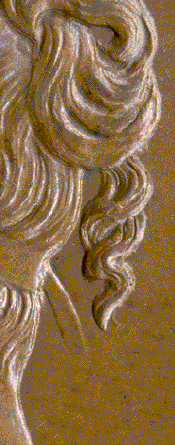
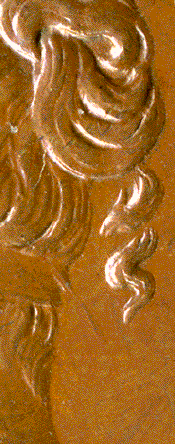
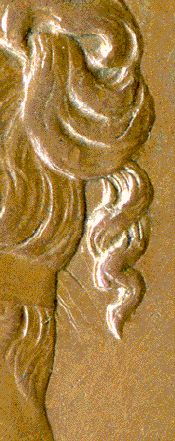
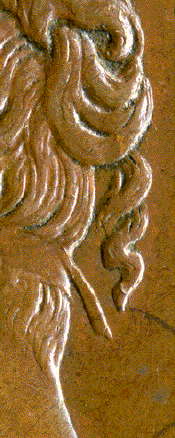
Tie ribbon (Type 1) Tie ribbon (Type 2) Tie ribbon (Type3) Tie ribbon (Type 4)
on CP1848Aa & Ab on CP1848Ab on CP1848Ac on CP1848Ad
CP1848 Aa & Ab - [Tie ribbon Type 1] - A single ribbon, which is fairly thick and approximately 3mm long and hangs downwards, comes from the back of Victoria's hair ribbon and extends below Victoria's pony tail, that hangs down
CP1848Ab - [Tie ribbon Type 2] - A tiny fragment of ribbon, juts out from the front, back of Victoria's hair ribbon - a single, fine strand which hangs down is just visible.
CP1848Ac - [Tie ribbon Type 3] - A single ribbon, similar to that on CP 1848Aa, but shorter as this one does not extend below the stand of hair hanging down but stops approximately 0.5 mm short. On Aa it extend nearly a mm further down. There is also the possibility that there is a very fine single strand below the thicker ribbon - about the same thickness as the strand hanging down from the Ab example.
CP1848 Ad - [Tie ribbon Type 4] - A single ribbon, which starts off narrow and then widens slightly, comes from the front of Victoria's hair ribbon and extends below Victoria's pony tail, that hangs down.
I discovered the variety listed here as CP 1848 Aa, in January 2009, whilst examining an 1848 penny and preparing it for listing for stock and the website. I then examined the rest of the 1848 pennies I had in stock and discovered other variations of this 'single ribbon tie'.
"What and why" was this 'single tie ribbon' doing on the coin ? It did not appear to be improvement to the original design as it looked out of place. Why on some pennies and then not on others ? There seemed to be more questions than answers. I could think of no good explanation for this variety until working at home, later that month that eventually I did work out " The what and the why" !
The solution:
The coin on the obverse appeared to have no aspect of ghosting or clashed dies. Apart from that 'single tie ribbon' otherwise the coin was clean of any other imperfection normally seen with clashed dies or ghosting.
On constantly turning the penny over and over it appeared that the variety on the obverse was in the area that Britannia's right arm and hand joined the shield, on the reverse. I scanned the reverse of the penny and then reversed the image and printed it to the exact size of the coin, on an overhead transparency. I laid the image of the reversed reverse onto the obverse of the coin and saw that in the area just below Britannia's elbow down to her wrist exactly matched the variety that I thought looked like a 'single tie ribbon' !
Note: On the die that would have been used to produce the reverse of the penny - Britannia would be in incuse or sunken on the die and the tiny area from her elbow to wrist would be flat or appear raised on the die.
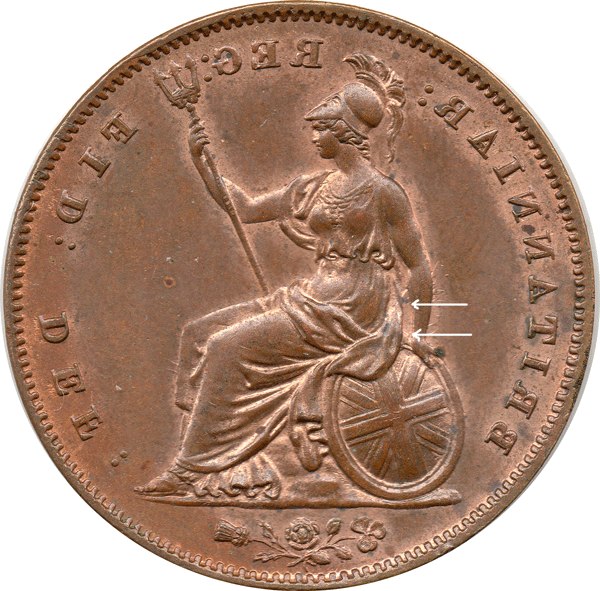
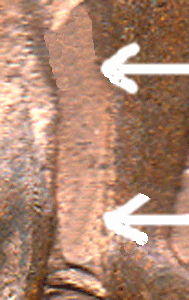
Therefore this is not a true variety in the real sense but the effect that clashing dies produce when the obverse die clashes with the reverse die. The differences of the length and width of this 'single tie ribbon' effect could depend on the pressure when the dies clash as some of the appearances of this effect can appear stronger than others - as can be seen by the difference in the pictures at the top.
All dates of pennies through from 1841 to 1860 have now been found with the 'die clashing' ribbons.
I have since been advised by Ian Fall, that Peck makes mention of this variety / clashed die effect in his book, English Copper, Tin and Bronze Coins in the British Museum, back in 1960 ! See page 404 for Peck's similar explanation as explained by the Royal Mint. It appears that I was trying to solve a problem that had already been solved ! I am pleased to say that the solutions were the same.
| Back to copper pennies |